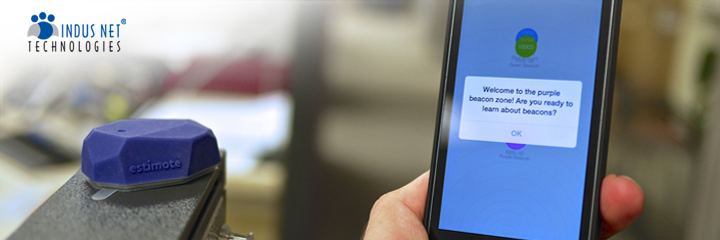
‘Beacon’ of hope for the Retail Sector
Did you know that the rise of smartphone shoppers boosted online retail spending to a record number of £133bn in the UK last year? Also, nearly 56% users of smartphones want to receive location-based offers on their devices once they are near a store. Mobile phones have completely revolutionized the way we shop. Yes, we know it’s an obvious today. The digital world has completely reshaped and redefined the retail industry, with online sales hitting the roof. The raging popularity of e-commerce platforms, especially Amazon, hasn’t gone down well with the brick-and-mortar retailers. They are literally feeling the heat. Big players such as JC Penny announced that it will close down nearly 140 stores and two distribution centers in the coming months. This isn’t good news for the retail sector. So, does this mean that brick-and-mortar retail stores will finally cease to exist? What should retailers do to entice the audience so that they feel compelled to step into their stores? There’s a popular saying that every cloud has a silver lining. Many of the brick-and-mortar stores today have made a smart move by adopting beacon technology to win back customers. This technology has also helped them gain their lost ground to a certain extent. Since most of the urban shoppers today are hooked onto smart devices to browse and research online for anything and everything, retailers are increasingly adopting this latest technology to tap the potential customers, win loyalty and drive sales. Fact is: retail is the most popular sector where beacon technology is being used now. What is beacon technology? In simple words, beacons are small devices (approximately 3cm x 5cm x 2cm), which use Bluetooth Low Energy (BLE) to transmit signals to smartphones within a short-range. Bluetooth LE is a proximity technology and the main purpose of beacons is “proximity marketing”. All you need to do is install this device or devices anywhere inside a retail store. It sends out signals to the app users whenever there are in the vicinity of the store. Beacons communicate with smartphone apps over Bluetooth, thus authorizing the retailers to send alerts to the devices of the customers. This way the brands can gather information on the shoppers’ movement inside the stores. Also, it enhances the shopping experience and makes shopping easier and quicker for the customers once they are inside a store. Types of beacon protocols Though the technology, “Bluetooth” was initiated by Nils Rydbeck, CTO at Ericsson Mobile in Sweden, and by Johan Ullman in 1989, it was in the year 2013, when Apple introduced iBeacon that the world stood up and took notice of beacon technology. In mid- 2013, Apple introduced iBeacon, the first beacon protocol in the market. In July 2015, Google announced Eddystone. Google’s beacon platform can transmit URLs to mobile devices, which can then be opened in a mobile browser. Beacons vs iBeacon Beacons are the hardware devices that send out and receive BLE signals. iBeacon, on the other hand, is a technology built into Apple devices that allows iPads and iPhones to scan for Bluetooth devices within a range. List of 10 beacon hardware manufacturers in the world: Estimote Gimbal Radius Networks BlueSense Gelo Sensorberg Glimworm Now, according to a report in BI Intelligence, these minute devices are the rapidly-growing in-store technology since mobile credit card readers. So, why are the retail giants taking resort to beacons, also called proximity beacons, to smarten up a store? Here are the top 4 reasons why beacons are winning the hearts of the brick-and-mortar retailers: More customer engagement by offering contextual information, targeted messages and notifications Building customer loyalty by sending personalized discounts and coupons in real-time Providing insights on customer purchase behaviour to enhance the shopping experience Providing contactless payment Beacons increase customer engagement Imagine, you are outside a shopping mall and the phone starts buzzing. You receive a notification reminding you to buy some clothing items. Beacons can encourage you (read a shopper) to come inside the store and complete the shopping. Now, once you enter the store, you start receiving messages explaining how to select the clothes. Retailers are leveraging the power of beacons to engage customers in the following ways: By sending welcome messages, promotional deals, reward points and pop-up alerts to a customer’s smartphone based on their shopping activities. By assigning sales assistant to a customer who spends considerable time near a particular product/section By pushing real-time offers to customers inside the store. It enriches the shopping experience and also helps in customer acquisition and retention. By flashing the descriptions of a product on the smartphone’s screen once a customer approaches a particular product inside the store. Did you know the Swan Centre in the UK became the first shopping mall to use beacons, which allowed them to organise in-store campaigns for its visitors? Using beacons to strengthen customer loyalty In today’s cut-throat competition, customers have countless options and can easily switch from one retail brand to another if they are not satisfied with the product or the service. Here the customer loyalty programs come into play. They are highly crucial for retailers to strengthen their relationship with the customers and also accelerate sales. According to a survey, 76% of customers believe that loyalty program strengthens their relationship with brands. Here’s how retailers can win the trust of the shopper and also convert visitors into buyers through beacon technology: The moment a loyal customer walks into a store, beacons allow retailers to send style tips and personalized content based on the location and purchase history. Retailers can use beacons to thank the customer for a purchase and also reward shoppers who have been loyal to the store. Did you know over 40% of shoppers look for offers on their smartphones while they are inside a store? Collecting customer data through beacons If a retail chain wants to present a supreme shopping experience to its customers, it should be aware of its customers’ buying patterns.